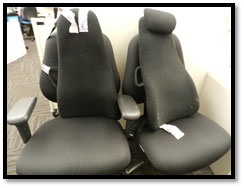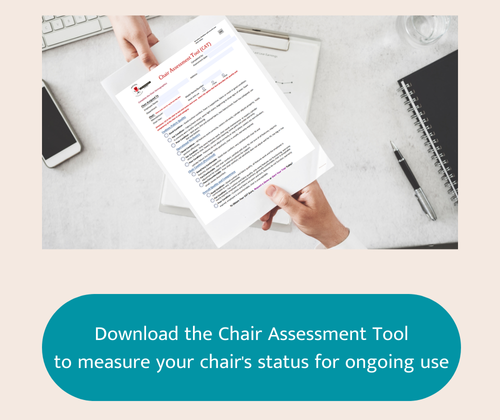
Do you know what you’re sitting on these days at work? What if the chairs your organization provided could give you a boost in energy and productivity? Or on the flip side, contribute to your aching back or neck? How would you know and what would you do?
I’ve evaluated thousands of ergonomic chairs in my career and I’ve come to the conclusion that often the chairs employers’ purchase directly relate to employee discomfort, distraction, and productivity loss contributing to many seated work injuries and the recent interest in the desire to stand at the office.
Ergonomic chairs are one of the most important capital assets an employer has that directly contributes to productivity and the bottom line. In fact, without a comfortable, functioning chair, your workforce has a difficult time being productive at a computer in the seated work environment. Yet, ergonomic chairs are often not selected based on employee anthropometrics (human measures), are not part of a preventive maintenance program or part of a life cycle asset management program to optimize their performance and ultimately your employees. Furthermore, how do you know when a chair has passed its peak performance, is at the end of its life cycle and is no longer providing value in the workplace?
In my experience, I have seen chairs become a significant liability contributing to the high cost of seated work because they are so poorly maintained, don’t fit properly, lack adjustability and/or they are no longer supportive. We’re talking about an average cost of $41,000.00 -$55,000.00 per workers’ compensation claim based on the latest data from the California Commission on Health, Safety and Workers’ Compensation.

Chairs are mechanical by nature and as such are prone to breakage and failure. Sinking cylinders, failing seat cushions, exposed and torn armrests, torn fabric with unsightly stains, broken casters. Chairs don’t last FOREVER! What is the message you are giving your employees when you don't maintain your chairs or provide good ergonomic seating with enough adjustment to effectively support the spine, buttocks, legs and upper extremities?
Just take a look around the office. Do you see employees covering chairs with padding, cushions, lumbar supports or even blankets? Are employees asking if they can sit on a “ball chair”? These are signs that your chairs just aren’t working well for your employees; not enough support, poor fit, even unsanitary. Employees often wind up playing "musical chairs" when their chair becomes intolerable or breaks, pushing them into a hallway or an empty cubical only for it to be picked up by another unsuspecting employee! Sound familiar? Do they even know who to call when the chair needs repair?
So, what are your two top challenges when it comes to chairs in your workplace? Is it chair quality, competency, fit or failure? Share your challenges below.


Comments